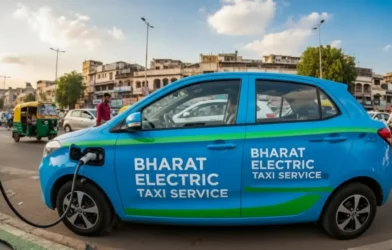Author: Aditya Pareek | EQMint
Company History
Ola Electric was founded in 2017 as a subsidiary of Ola (ANI Technologies) to address India’s growing need for clean, affordable mobility solutions. While Ola initially disrupted ride-hailing, Ola Electric was created to take on an even bigger challenge — to transition India away from fossil fuels and toward a future powered by electric mobility.
In its early years, Ola Electric focused on pilot projects such as building EV fleets and deploying charging infrastructure. The real breakthrough came in 2019, when Ola Electric received a $250 million investment from SoftBank, propelling it into the unicorn club within just two years of its inception.
By 2021, the company unveiled its flagship Ola S1 and S1 Pro electric scooters, manufactured at the state-of-the-art “Futurefactory” in Krishnagiri, Tamil Nadu. Touted as the world’s largest two-wheeler EV factory, the facility is designed to produce millions of scooters annually and is run almost entirely by women workers.
Ola Electric positioned its scooters as affordable, feature-rich, and futuristic alternatives to petrol two-wheelers, targeting India’s massive scooter and motorcycle market. With high-speed connectivity, app integration, and advanced features like cruise control, Ola scooters attracted wide attention.
Over the years, Ola Electric has expanded its product lineup, launched the Ola Hypercharger network, and announced plans to build electric motorcycles, cars, and even solid-state batteries. In 2023, the company filed for India’s largest EV IPO, aiming to raise funds to scale manufacturing, R&D, and infrastructure.
By 2025, Ola Electric has established itself as one of India’s most valuable EV companies, symbolizing the country’s push toward sustainable transportation.
Founders
Ola Electric was founded by Bhavish Aggarwal, who also co-founded Ola Cabs. Aggarwal envisioned the company as more than just an EV manufacturer — he saw it as an energy and technology company building the full EV ecosystem.
Aggarwal’s leadership has been central to Ola Electric’s growth. He drove initiatives like the Futurefactory, invested heavily in battery innovation, and consistently advocated for India’s self-reliance in EV technology. His belief is that India should not merely import EV solutions but create indigenous products tailored to Indian roads, weather, and consumer needs.
Under his vision, Ola Electric has grown into a vertically integrated company that spans vehicles, batteries, charging infrastructure, and mobility services.
Business Model
Ola Electric operates a vertically integrated EV ecosystem, combining vehicles, batteries, charging, and software. Its business model can be understood across key pillars:
Electric Two-Wheelers
- The core of Ola Electric’s business is its S1 series scooters, priced to compete directly with petrol scooters.
- Features like long range, app-based controls, fast charging, and stylish designs help attract urban youth and professionals.
- Ola plans to expand into electric motorcycles and mass-market bikes, further strengthening its portfolio.
Futurefactory Manufacturing
- Ola’s mega factory in Tamil Nadu is one of the world’s largest EV two-wheeler plants, designed for high automation and scale.
- Mass production lowers costs, enabling competitive pricing in India’s price-sensitive market.
Battery Technology & R&D
- Ola Electric is investing in cell manufacturing to reduce dependence on imports and improve energy density.
- R&D into solid-state batteries and localized sourcing is a long-term focus.
Charging Infrastructure (Hypercharger Network)
- Ola is building a nationwide fast-charging network to address range anxiety.
- Charging stations are positioned across cities, highways, and commercial hubs.
Software & Connectivity
- Ola scooters come with OTA (over-the-air) updates, AI-powered diagnostics, navigation, music control, and personalization features.
- This transforms scooters from simple vehicles into connected smart devices on wheels.
Mobility Services Integration
- Ola Electric integrates with Ola’s ride-hailing platform, enabling fleet operators and consumers to adopt EVs at scale.
- Leasing, subscriptions, and financing options are being developed to lower entry barriers.
Revenue Streams
- Vehicle sales remain the primary revenue source.
- Ancillary revenues come from extended warranties, service, charging, and future subscription models.
- As the battery ecosystem matures, licensing or B2B sales of cells could emerge as another revenue driver.
Current Competitors
Ola Electric faces intense competition from both Indian and global EV players. Key competitors include:
- Ather Energy — premium electric scooter maker with strong focus on performance and customer experience.
- TVS iQube — from traditional two-wheeler giant TVS Motors, offering affordable e-scooters.
- Bajaj Chetak EV — revival of the iconic Chetak brand as an electric scooter.
- Hero MotoCorp — the world’s largest two-wheeler manufacturer, investing heavily in EVs.
- Simple Energy, Bounce Infinity, Okinawa — Indian EV startups competing in the scooter market.
- Global giants like Tesla, BYD, and Honda could pose competition once they scale EVs in India, particularly in cars and batteries.
Despite the competition, Ola Electric’s aggressive pricing, scale, and brand positioning give it an edge in India’s EV adoption journey.
Challenges & Risks
Ola Electric’s ambitious rise comes with challenges:
- Quality & reliability issues: Early scooters faced criticism over battery performance, software glitches, and service delays.
- Customer trust: Delivering consistent after-sales service remains critical in the long term.
- High burn rate: Manufacturing plants, R&D, and infrastructure require heavy capital, raising concerns about profitability.
- Regulatory hurdles: EV policies, subsidies, and safety regulations impact operations.
- Global supply chain: Dependence on imported battery cells and components makes Ola vulnerable to global disruptions.
- Competition: Traditional auto giants entering EVs with deep pockets and distribution networks can challenge Ola’s growth.
Future Outlook
Ola Electric is more than a scooter company; it is building an entire EV ecosystem. Looking ahead, the company is likely to focus on:
- Launching electric motorcycles and affordable mass-market EVs.
- Expanding the Hypercharger network across all major highways and cities.
- Accelerating battery innovation, with an eye on solid-state breakthroughs.
- Strengthening after-sales service and reliability to build customer trust.
- Scaling up exports to international markets, starting with Asia and Europe.
- Going public via its planned IPO to raise capital for further expansion.
If Ola Electric executes well, it has the potential to not only dominate India’s EV two-wheeler market but also emerge as a global EV leader from the Global South.
References
- Wikipedia – Ola Electric
- Economic Times – Ola Electric files for ₹5,500 crore IPO
- Moneycontrol – Ola Electric enters unicorn club with $250M funding from SoftBank
- Forbes India – Inside Ola Electric’s Futurefactory
Disclaimer: This article is based on information available from public sources. It has not been reported by EQMint journalists. EQMint has compiled and presented the content for informational purposes only and does not guarantee its accuracy or completeness. Readers are advised to verify details independently before relying on them.









